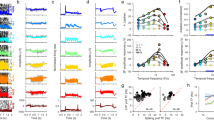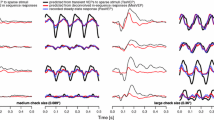Visual evoked potentials produced in response to a reversive checkerboard pattern presented in conditions of additive noise were recorded. Changes induced by noise in both the shapes of evoked potentials and the structure of the test stimulus were compared. The nature of changes in the shapes of evoked potentials was found to correlate with the nature of changes in the amplitude-frequency spectrum of the stimulus. These results support the gestalt psychology point of view that the visual system uses spatial frequency rather than discrete means for describing information.
Similar content being viewed by others
References
B. G. Anan’ev, M. D. Dvoryashina, and N. A. Kudryavtseva, Individual Human Development and the Constancy of Perception [in Russian], Prosveshchenie, Moscow (1968).
M. Arbib, The Metaphorical Brain [Russian translation], Mir, Moscow (1976).
Aristotle, Posterior Analytics. Collected Writings [Russian translation], Mysl’, Moscow, Vol. 2, pp. 255–346.
É. G. Vatsuro, I. P. Pavlov’s Studies of Higher Nervous Activity [in Russian], Ministry of Education of the RSFSR Press, Moscow (1955).
D. Gibson, An Ecological Approach to Visual Perception [Russian translation], Progress, Moscow (1988).
V. D. Glezer, K. N. Dudkin, A. M. Kuperman, L. I. Leushina, A. A. Nevskaya, N. F. Podvigin, and N. V. Prazdnikova, Visual Recognition and Its Neurophysiological Mechanisms [in Russian], Nauka, Leningrad (1975).
D. V. Glezer, N. V. Prazdnikova, L. I. Leushina, A. A. Nevskaya, and M. B. Pavlovskaya, “The description of visual images,” in: Visual Physiology (Handbook of Physiology), A. L. Byzov (ed.), Nauka, Moscow (1992), pp. 466–527.
R. M. Granovskaya, Perception and Models of Memory [in Russian], Nauka, Leningrad (1974).
K. N. Dudkin, Visual Perception and Memory [in Russian], Nauka, Leningrad (1985).
D. Keisasent, “Recognition of objects and features,” in: Optical Holography [Russian translation] G. Colfield (ed.), Mir, Moscow (1982), Vol. 2, pp. 550–594.
D. I. Kirvyalis, “Theoretical basis of visual analyzers,” in: Visual Systems. Proceedings of the All-Union Symposium “Vision in Organisms and Robots” [in Russian], Vilnius (1987), pp. 6–46.
F. Kliks, Problems in the Psychophysiology of the Perception of Space [in Russian], Progress, Moscow (1965).
N. N. Krasil’nikov, Theory of Image Transmission and Perception [in Russian], Radio i Svyaz, Moscow (1986).
G. F. Lakin, Textbook for Biological Specialists in Colleges [in Russian], Vysshaya Shkola (1990).
L. I. Leushina, A. A. Nevskaya, and M. B. Pavlovskaya, “Asymmetry in the hemispheres from the point of view of the recognition of visual images,” Sensor. Sistemy, 3, No. 4, 76–92 (1982).
T. Likhi, The History of Contemporary Psychology [in Russian], Piter, St. Petersburg (2003).
D. Marr, An Informational Approach to Studies of the Representation and Processing of Visual Images [Russian translation], Radio i Svyaz, Moscow (1987).
A. V. Merkul’ev, S. V. Pronin, L. A. Semenov, N. Foreman, V. N. Chikhman, and Yu. E. Shelepin, “Threshold signal:noise ratios in the perception of fragmented figures,” Ros. Fiziol. Zh. im. I. M. Sechenova, 90, No. 11, 1348–1355 (2004).
L. F. Petrova, V. P. Smirnov, O. V. Alekseev, Yu. K. Allik, and A. V. Pul’ver, “Visual perception of images,” in: Processing of Optical Images [in Russian], M. M. Miroshnikov (ed.), S. I. Vavilov GOI, St. Petersburg (1990), No. 10.
A. Poincare, Science [Russian translation], Nauka, Moscow (1990).
A. For, Image Perception and Recognition [in Russian], Mashinostroenie, Moscow (1989).
A. K. Kharauzov, Yu. E. Shelepin, S. V. Pronin, N. N. Krasil’nikov, and S. V. Murav’eva, “Visual evoked potentials on dichotic presentation of test sinusoidal gratings and interference,” Ros. Fiziol. Zh. im. I. M. Sechenova, 87, No. 2, 261–270 (2001).
M. G. Yaroshevskii, The History of Psychology [in Russian], Mysl, Moscow (1976).
A. Desolneux, L. Moisan, and J.-M. Morel, From Gestalt Theory to Image Analysis. A Probabilistic Approach, New York (2006).
A. Ginsburg, The Perception of Visual Form: a Two-Dimensional Filter Analysis. Information Processing in the Visual System, Leningrad (1976), pp. 46–51.
L. D. Harmon and B. Julesz, “Masking in visual recognition. Effects of two-dimensional filtered noise,” Science, 180, 1194–1197 (1973).
B. Julesz, E. N. Gilbert, and J. D. Victor, “Visual discrimination of textures with identical third-order statistics,” Biol. Cybernet., 31, 137–140 (1978).
K. Koffka, Principles of Gestalt Psychology, New York (1978).
W. Kohler, “Gestalt psychology today,” Amer. Psychol., 14, 727–734 (1959).
K. S. Lashley, Brain Mechanisms and Intelligence, Chicago University Press (1929).
K. S. Lashley, “The mechanism of vision. Preliminary studies of the rat’s capacity for detail vision,” J. Gen. Psychol., 18, 123–193 (1938).
A. L. Ochs, “Is Fourier analysis performed by the visual system or by the visual investigator?” J. Opt. Soc. Amer., 69, No. 1, 95–98 (1979).
L. H. Van der Tweed, “Pattern evoked potentials: facts and considerations,” in: Proc. of the 16th ISCEV Symposium, Morioka (1979), pp. 27–46.
M. Wertheimer, “Laws of organization in perceptual forms,” first published as “Untersuchungen zur Lehre von der Gestalt II,” in: Psycologische Forschung, 4, 301–350 (1923). Translation published in A Source Book of Gestalt Psychology, Ellis, W. (ed.), Routledge & Kegan Paul, London (1938), pp. 71–88.
Author information
Authors and Affiliations
Corresponding author
Additional information
Translated from Rossiiskii Fiziologicheskii Zhurnal imeni I. M. Sechenova, Vol. 94, No. 8, pp. 928–944, August, 2008.
Rights and permissions
About this article
Cite this article
Merkul’ev, A.V., Merkul’eva, N.S. Effects of Amplitude-Frequency Characteristics of a Noise-Masked Test Stimulus on the Shapes of Visual Evoked Potentials. Neurosci Behav Physi 39, 683–694 (2009). https://doi.org/10.1007/s11055-009-9178-7
Received:
Revised:
Published:
Issue Date:
DOI: https://doi.org/10.1007/s11055-009-9178-7




